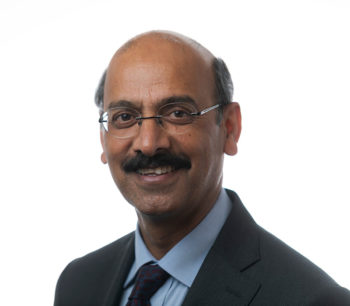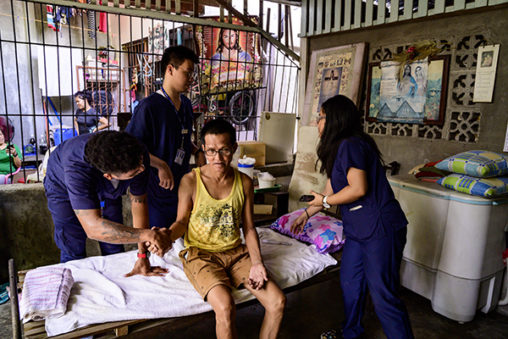
As the world comes to terms with the COVID-19 pandemic, a critical window of opportunity has opened to strengthen our health systems globally. In the latest issue of our peer-reviewed journal, Public Health Research & Practice, Guest Editor Dr Abdul Ghaffar, Executive Director of the Alliance for Health Policy and Systems Research, World Health Organization, wrote about how health policy and systems research (HPSR) is essential for building strong, equitable and evidence-informed health systems.
Dr Ghaffar has worked for over 35 years in low- and middle-income countries managing research for health and planning, designing and evaluating national health systems. Here, he explains HPSR, the lingering challenge of funding, and what’s at stake for our health systems.
Sax Institute: What is HPSR, and why is it important?

Dr Ghaffar: The field of health policy and systems research seeks to understand and improve how societies organise themselves in achieving collective health goals. It’s not just about doctors, nurses and the medical profession, but how we do this as a society. Health is everybody’s business and everybody has to play a role.
HPSR has emerged because there is very limited local knowledge to make policy-relevant decisions for stronger health systems, especially in low- and middle-income countries. The need to invest in HPSR was identified and recommended by a WHO ad-hoc committee on health research in 1996. Since then, investments in and capacity to conduct and use HPSR have increased exponentially.
However, it remains important because despite increased funding for HPSR over the years, capacities to generate and use policy relevant knowledge are still very limited in most countries of the world. This is resulting in inefficient use of resources and poor performance of health systems.
Q: Can you give us an example of HPSR in practice, where it’s delivering real-world outcomes to improve health?
A: The governments of India and Pakistan approached the WHO in 2019 because they had launched health insurance programs in their countries, which were very well planned and conceptualised, but there were natural challenges in implementation given the size and scale of these programs, and the systems that needed to be put in place. These included challenges around ensuring that people were informed, around ensuring that hospitals followed standard procedures during care, and mitigating the potential for insurance fraud.
They approached us to see how they could improve the implementation of these large publicly funded health insurance programs. We worked with the national health authorities to try to understand the barriers, and how these could be mitigated by improving the implementation challenges.
People do different things to disseminate and communicate health messages, and in India’s rural areas, we found that people were getting a letter from the central government with a photograph of the Prime Minister of India on it. However, despite receiving the letter, our researchers found that many people remained unaware of the insurance program due to insurance being included as just one of many programs mentioned in the letter, pointing to the importance of simplifying messaging.
Our work with the Indian government also led us to uncover some unintended consequences of the way that the program was designed. The insurance program typically reimburses care in empanelled public and private facilities. In one state, with a view to contain costs, certain cancer-related procedures were only reimbursed if carried out at public facilities, whereas other cancer-related procedures were reimbursed at both public and private facilities.
This created a great deal of confusion among patients who were admitted to private hospitals believing their care was covered. Many of them received unexpected bills for part of their care that was not reimbursed. Our research was able to bring this to the attention of the insurance program, enabling them to make the necessary adjustments.
Q: The papers published in this issue show an under-funding of HPSR, especially in the developing world, compared with medical and clinical research. Why do you think this is?

A: The reasons for underfunding are many. Firstly, there is a stronger emphasis and attention on clinical and medical research because of the known benefits, and more influential and long-standing institutional legacies.
But if we look at the COVID-19 vaccine for example – some countries have very low vaccination because they don’t have the system to deliver it. If I can give you an analogy: space agencies don’t just build beautiful rockets. They invest in the launching pads too. We need to be investing in launching pads.
Another reason for under-funding is that health research follows the trend of over-medicalisation and tends to be more diseases oriented instead of focusing on preventive, promotive and social science research.
There is also a strong lobby, especially among funders, for everything to be measured through causal models using linear models of planning and measurement. We can easily see the link between inputs and outputs, but what has been delivered? What is the outcome? What is the impact? This is where HPSR really plays a role and needs to be considered.
Q: What are the key things we can do to improve the situation with HPSR funding, research capacity and recognition of the value of HPSR for strengthening health systems?
A: What we are promoting is that systems and policy research should be included in the budgets of health systems and programs, rather than including it in the research budgets of health ministries or medical research councils. This isn’t the kind of research that needs long cycles of funding, this research is primarily to respond to the demands and needs of policy and decision-makers.
The second thing is we need to make a better case for the use, utility and benefits of HPSR, especially for stronger health systems.
In HPSR, we don’t test a hypothesis. We solve problems. And to solve these problems you might have to use epidemiology, social science, economics etc. A vaccine you can see – but is there money for delivering a vaccine? This is a problem that HPSR can solve.
Other things to consider are developing new methods, tools and frameworks to measure and monitor HPSR, including an agreement on HPSR-specific MeSH (MEdical Subject Headings) terms.
Q: What are some of the things that the WHO’s Alliance for HPSR is doing/focusing on?
A: The Alliance has pioneered many approaches, nurtured new concepts, and introduced innovations in the design and conduct of HPSR. We have, with our partners, transformed the field in terms of methodological foundations, capacity strengthening and widening its policy influence.
In the special issue of Public Health Research & Practice, we have worked with partnering researchers to provide the most comprehensive analysis to date of the state of funding for HPSR, covering all WHO regions worldwide. The papers in the issue show that funding for HPSR at country level remains a serious challenge, however they provide a starting point to understand the challenges and possibilities of building national capacity to conduct HPSR.
Q: What is the future for HPSR and are you optimistic that it will continue to grow as a valued research discipline globally?
A: As the world has realised during the pandemic and learned while implementing the United Nations Sustainable Development Goals (SDGs), there is no one sector or section of the society which can respond to these challenges alone. That is, and will be, true for the health research community.
These realisations are forcing all of us to do more and more transdisciplinary research, and thankfully HPSR by nature is transdisciplinary. So, I am not only optimistic but very confident that the world will not achieve either SDGs and control/manage the ongoing pandemic, unless they invest in transdisciplinary research such as HPSR.
Our sincere thanks to the Alliance for Health Policy and Systems Research, World Health Organization, which supported this issue of PHRP and worked in partnership with us to develop it, and to the Guest Editors, Dr Abdul Ghaffar, Professor Vivian Lin, Professor K. Srinath Reddy and Dr Khor Swee Kheng, whose input was invaluable.
Public Health Research & Practice is an Australian health journal that is committed to publishing innovative, high-quality papers that inform public health policy and practice.
Read the full issue of PHRP
Find out more about HPSR on the WHO website
